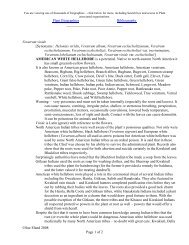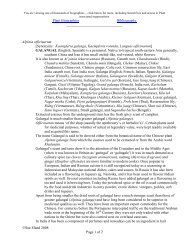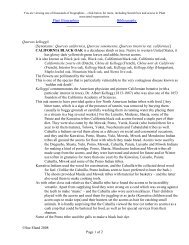watercress - Plant Biographies
watercress - Plant Biographies
watercress - Plant Biographies
Create successful ePaper yourself
Turn your PDF publications into a flip-book with our unique Google optimized e-Paper software.
vulgaris), stinging nettle (Urtica dioica), thyme (Thymus vulgaris) and wood betony<br />
(Stachys officinalis) was one of the Nine Sacred Herbs for the Anglo-Saxons. (Some<br />
authorities believe that the ninth could have been sainfoin, Onobrychis viciifolia.) They<br />
believed that the plants could give protection against evil.<br />
It was used as a strewing herb.<br />
If traditional stories are to be believed the Greek historian and military commander, Xenophon<br />
(c.435-354) who early in his career served as a Greek mercenary under the Persian<br />
prince, Cyrus the Younger (424-401 BC) is said to have promoted <strong>watercress</strong> among the<br />
Persians he met at that time. It was a familiar plant to both the ancient Greeks and the<br />
Romans and the latter are understood to have considered it as a desirable part of diets for<br />
the mentally ill.<br />
Both medicinal and aromatic qualities of <strong>watercress</strong> (probably collected from the wild) were<br />
recognized by the Romans and it has been cultivated in northern Europe, particularly<br />
France and the Netherlands, for centuries. It seems that the first commercial <strong>watercress</strong><br />
beds to be established in England only made their appearance in Kent in about 1808.<br />
More are said to have followed quite quickly in the counties surrounding London for<br />
which they primarily catered. Some of the track of the old railway lines that was laid<br />
specifically to carry the fresh plant to the metropolis from places further afield still exists.<br />
One example is that from Arlesford in Hampshire where <strong>watercress</strong> beds are still thriving<br />
and the line is familiarly known today as the ‘Watercress Line’.<br />
In Britain many used to believe that <strong>watercress</strong> should not be harvested when there was an ‘R’<br />
in the month. This in effect excluded the Summer months and authorities seem to be of<br />
two minds as to whether it was explained by the fact that wild <strong>watercress</strong> flowers then –<br />
or that at that time water levels could be lower and the water less free-flowing which<br />
might lead to a dirty crop.<br />
Although today the leaves are familiar as a salad and flavouring they used to be cooked like<br />
spinach (Spinacia oleracea) even as recently as the 1930s.<br />
Fishermen are said to welcome <strong>watercress</strong> especially in trout streams as it attracts many of the<br />
creatures the fish feed upon. Watercress is also much enjoyed by ducks.<br />
Unusually for a salad plant <strong>watercress</strong> has heraldic connections. (If one overlooks the<br />
illogicality as it ignores the fact that <strong>watercress</strong> grows in running water the following tale<br />
is delightful.) The story goes that while out hunting in the Summer heat in the<br />
countryside north-west of Paris the French king, Louis IX (otherwise known as St. Louis)<br />
(1215-1270) became desperate for a drink. He was offered <strong>watercress</strong> to quench his thirst<br />
(as it is said that no liquid was near) and was so pleased by its refreshing taste that he<br />
wanted to commemorate the little plant and the place where it was found. Coincidentally<br />
or not the French city of Vernon claims that its coat of arms dates back to the 13<br />
©Sue Eland 2008<br />
Page 2 of 3<br />
th<br />
Century and this contains three bunches of <strong>watercress</strong>.<br />
At some point the plant reached North America and there it came to be known by several North<br />
American Indian tribes. The Cherokee, Havasupai, Okanagan-Colville, some of the<br />
Algonkin, the Saanich, Diegueño, Luiseño , Gosuite, Cahuilla, Tubatulabal, Kawaiisu,<br />
Iroquois and Karok tribes all ate it as a vegetable particularly in salads. The Mendocino<br />
Indian tribe viewed it more as a relish, and records suggest that the Okanagan-Colville<br />
relied upon it especially as a famine food. It was also a source of medicine for several<br />
tribes. Apparently the Okanagan-Colville applied it fresh to the forehead in poultices to<br />
ease both headaches and dizziness. Both the Mahuna and Costanoan Indians valued it for<br />
treating liver problems, and the latter also used it to ease fever and kidney disorders.<br />
Watercress is prized by the cosmetics industry as it can help to make the skin smooth and white<br />
– and it can be an ingredient in bath gels.<br />
The juice is used by the tobacco industry as a nicotine solvent.
















